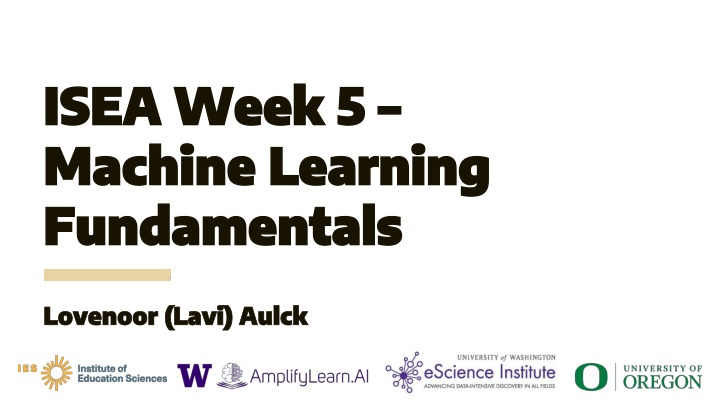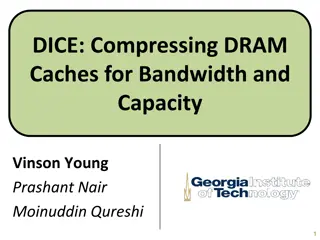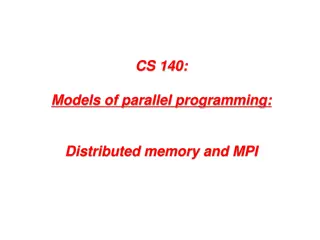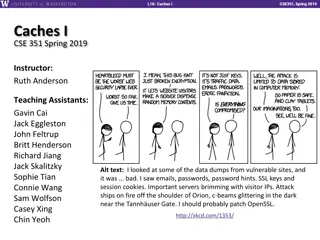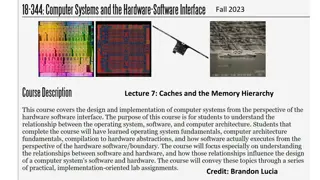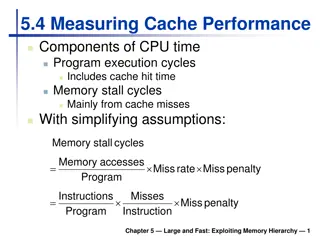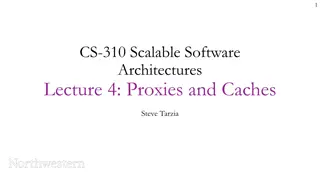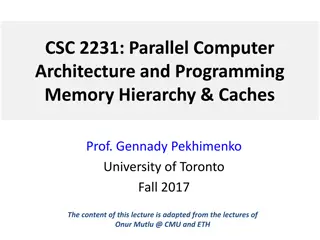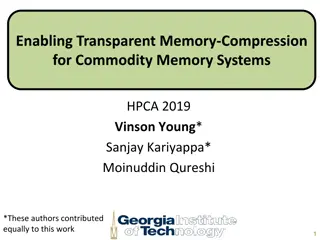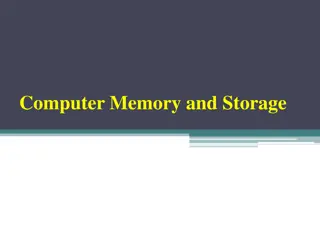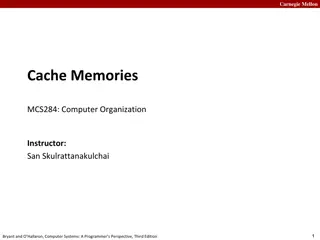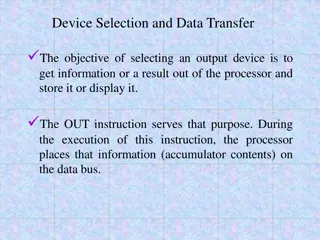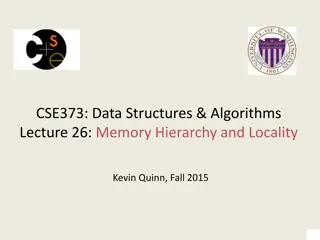Review of Caches and Memory Hierarchy - Understanding Single Processor Performance
Most applications in a single processor run at only 10-20% of the processor peak, with performance loss mainly in the memory system. This review covers the typical memory hierarchy, idealized uniprocessor model, and real-world challenges in optimizing program performance.
Download Presentation

Please find below an Image/Link to download the presentation.
The content on the website is provided AS IS for your information and personal use only. It may not be sold, licensed, or shared on other websites without obtaining consent from the author.If you encounter any issues during the download, it is possible that the publisher has removed the file from their server.
You are allowed to download the files provided on this website for personal or commercial use, subject to the condition that they are used lawfully. All files are the property of their respective owners.
The content on the website is provided AS IS for your information and personal use only. It may not be sold, licensed, or shared on other websites without obtaining consent from the author.
E N D
Presentation Transcript
ISEA Week 5 ISEA Week 5 Machine Learning Machine Learning Fundamentals Fundamentals Lovenoor (Lavi) Aulck Lovenoor (Lavi) Aulck
Outline Outline > Level-setting > Model Selection > Warm Up Exercise > Machine Learning Overview > Basics > Programming Exercise
Who Am I? Who Am I? PhD Student at UW Focus on how higher ed institutions can better use their data Whitaker International Research Fellowship in Amsterdam, NL BS in BioE BA in Comp. Religion 2011 2013 2014 2012 2014 - 19 2019 - Now MS in BioE from UW Research Engineer at UW Medical Center Data Scientist in UW Provost s Office
You Will Need You Will Need > You will need to have the following python packages installed and working for the demos: pandas numpy seaborn (and/or matplotlib) sklearn statsmodels random
A Data Scientist A Data Scientist Stephan Kolassa
A Data Scientist A Data Scientist Domain expertise Stephan Kolassa
A Data Scientist A Data Scientist Domain expertise Critical thinking, creativity, and experimental design? Stephan Kolassa
A Data Scientist A Data Scientist Domain expertise Critical thinking, creativity, and experimental design? Stephan Kolassa
A Data Scientist A Data Scientist Joe Blitzstein
A Data Scientist A Data Scientist Ask an interesting question Explore the data Communicate and visualize Get the data Model the data
A Data Scientist A Data Scientist Ask an interesting question Clean/Curate the data Communicate and visualize Explore the data Get the data Model the data
A Data Scientist A Data Scientist Data ethics Ask an interesting question Clean/Curate the data Communicate and visualize Explore the data Get the data Model the data
A Data Scientist A Data Scientist Data ethics Ask an interesting question Clean/Curate the data Communicate and visualize Explore the data Get the data Model the data
How To Build A Model (A Game) How To Build A Model (A Game) Examine outputs from regression model Build a regression model using explanatory variables of interest Expand and iterate on model Clean/curate the data Explore the data and calculate descriptive statistics of the variables in the dataset Examine outputs from expanded regression model We specify a question and ensure we have the data to answer the question
How To Build A Model (A Game) How To Build A Model (A Game) We specify a question and ensure we have the data to answer the question Clean/curate the data Explore the data and calculate descriptive statistics of the variables in the dataset Build a regression model using explanatory variables of interest Examine outputs from regression model Expand and iterate on model Examine outputs from expanded regression model
Multiple Paradigms of Regression Multiple Paradigms of Regression > Statistics/economics: explain a relationship Ties in with the idea of inference
Multiple Paradigms of Regression Multiple Paradigms of Regression > Statistics/economics: explain a relationship Ties in with the idea of inference > Machine learning: predict the future Ties in with the idea of prediction
Example: Earnings Example: Earnings > Inference What are the determinants of income? Do people with children earn more? On average, how much more will a person earn for each additional year of schooling?
Example: Earnings Example: Earnings > Inference What are the determinants of income? Do people with children earn more? On average, how much more will a person earn for each additional year of schooling? > Prediction What is the predicted income for person X? What are the descriptors of a person with income Y?
Example: Earnings Example: Earnings
Example: Earnings Example: Earnings > Linear regression offers a concise summary of the mean of one variable as a function of the other variable(s) through two parameters: the slope and intercept of the line
Example: Earnings Example: Earnings > Linear regression offers a concise summary of the mean of one variable as a function of the other variable(s) through two parameters: the slope and intercept of the line > Model:
Example: Earnings Example: Earnings > Linear regression offers a concise summary of the mean of one variable as a function of the other variable(s) through two parameters: the slope and intercept of the line > Model: > Have we measured the causal effect of an additional year of education on wages?
Example: Earnings Example: Earnings > Linear regression offers a concise summary of the mean of one variable as a function of the other variable(s) through two parameters: the slope and intercept of the line > Model: > Have we measured the causal effect of an additional year of education on wages? With another year of education, will I definitely earn $2,518 more?
The Model Is Right? The Model Is Right ? All models are wrong but some are useful > - George Box all models are limited by the validity of the assumptions on which they ride > - Collier, Sekhon, and Stark Assumptions behind models are rarely articulated, let alone defended. > - David Freedman
Models for Predictions Models for Predictions > All models are, in small or large part, wrong Miss features, omit dependencies, make assumptions, etc
Models for Predictions Models for Predictions > All models are, in small or large part, wrong Miss features, omit dependencies, make assumptions, etc > Models provide a simplification Require assumptions Require some understanding/intuition
Models for Predictions Models for Predictions > All models are, in small or large part, wrong Miss features, omit dependencies, make assumptions, etc > Models provide a simplification Require assumptions Require some understanding/intuition > But what do we need for prediction?
Models for Predictions Models for Predictions > But what do we need for prediction? If all we care about is predicting some target variable, maybe we can just ignore some of the messy assumptions and focus on specific metrics?
Models for Predictions Models for Predictions > But what do we need for prediction? If all we care about is predicting some target variable, maybe we can just ignore some of the messy assumptions and focus on specific metrics? > A critical concern of machine learning is the ability to build models that accurately generalize while a critical concern of econometrics is the ability to build models that capture relationships
What is Machine Learning? What is Machine Learning? > Machine learning is the science of getting computers to act without being explicitly programmed > Machine learning is a scientific discipline that explores the construction and study of algorithms that learn from data > Machine learning is a natural outgrowth at the intersection of computer science and statistics
What is Machine Learning? What is Machine Learning? Artificial Intelligence Machine Learning Deep Learning ?? Borrowed from Nvidia 1950s 2010s
What is Machine Learning? What is Machine Learning? Traditional Programming Data Computer Output Program Machine Learning ?
What is Machine Learning? What is Machine Learning? Traditional Programming Data Output Computer Program Machine Learning Data Program Computer Output
What is Machine Learning? What is Machine Learning? Learning is (like) farming, which lets nature do most of the work. Farmers combine seeds and nutrients to grow crops. Learners combine knowledge with data to grow programs. - Pedro Domingos
Flavors of Machine Learning Flavors of Machine Learning > Supervised learning > Unsupervised learning > Semi-supervised learning > Reinforcement learning
Supervised Learning Supervised Learning > We know the correct answer for values We re trying to model the input (independent) variables as they relate to the output (dependent) variables > Examples Predicting whether a student will graduate from a university Predicting salary upon graduation Other examples?
Unsupervised Learning Unsupervised Learning > We don t know the correct answer for values We re trying to discover underlying structure > Examples Extracting topics/themes from textual surveys of students Understanding the relationships between different departments/programs Finding bottlenecks in student course offerings
Pop Quiz Pop Quiz Would you address each of the below with a supervised or unsupervised learning algorithm? > Given email labelled spam or not, build a spam detector > Given news articles on the web, group them into sets based on topic > Given a database of customer data, find market segments/customer groups > Given patients with a disease, determine if new patients have the disease > Given phone records of individuals, determine which are the wealthiest > Given phone records of individuals and survey data about their income, predict the incomes of new subscribers
Semi Semi- -supervised Learning supervised Learning > We know the correct answer for some values The input data contains both labelled and unlabeled instances > Examples?
Reinforcement Learning Reinforcement Learning > We develop agents that seek to maximize reward We re trying to build models that will seek to maximize some gain > Examples Creating personalized curricula for students Creating educational content for students
ML Basics ML Basics > Thousands of ML algorithms No one knows them all Often tweaks or small improvements to existing approaches
ML Basics ML Basics > Thousands of ML algorithms No one knows them all Often tweaks or small improvements to existing approaches > Every ML algorithm has three components The representation (the model) The evaluation (the cost/objective function) The optimization (the search)
Designing for Prediction: Key Ideas Designing for Prediction: Key Ideas > Generalization and overfitting > Training, validation, and test data > Evaluation metrics > Baselines > Error analysis
Modeling Education and Income Modeling Education and Income
Modeling Education and Income Modeling Education and Income
Modeling Education and Income Modeling Education and Income
Modeling Education and Income Modeling Education and Income One Variable Kitchen Sink Plotting
Modeling Education and Income Modeling Education and Income One Variable Kitchen Sink Plotting Which of these would you trust for predictions when education is 8 years?
Modeling Education and Income Modeling Education and Income One Variable Kitchen Sink Plotting Which of these would you trust for predictions when education is 8 years? What about 16 years? What about 0 years?
